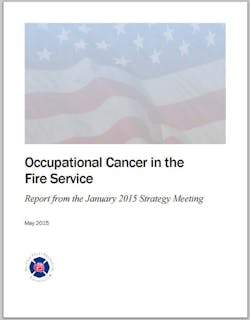Numerous studies have pointed to the correlation between firefighters and cancer, but are personnel listening?
Firefighters, officers, researchers and other stakeholders say "No."
That was just one of the findings included in a report compiled after a two-day meeting in January. Firefighter cancer was listed as a priority during Tampa 2 in 2014.
“Provide firefighters with information on steps they can take to reduce the incidence of occupational cancer – including diet, physical conditioning, use and proper maintenance of personal protective equipment (PPE), tobacco cessation programs, and other steps," the report states.
Stakeholders also said it's imperative that a single unified message about occupational cancer be established.
Among their recommendations include:
- Require PPE during the overhaul process at fires and continue to research improvements for the level of protection provided by PPE.
- Creation of a firefighter cancer registry to gather data prior to death since death certificates are not always a reliable source of data on the cause of death, employment history or contributing factors to the death.
- Increase awareness of the importance in reducing cancer risks by management of diet, exercise, weight, sunscreen use, tobacco use and overall wellness.
- Continue to work on presumptive cancer legislation to reduce the burden of proof for causation and allow for individual case evaluation.
A NIOSH study that involved career personnel in San Francisco, Philadelphia and Chicago found “excess solid cancers” in firefighters with the following types of cancer: digestive, genitourinary (kidney, bladder, prostate), oral, respiratory, and mesothelioma, the document stated.
While stakeholders heard from researchers, it was determined that additional data needs to be compiled. Also, many personnel such as females, minorities, volunteers and wildland have been under-represented in studies. They also learned:
- There are currently no studies showing the impact of exposures from previous employment or secondary jobs.
- Current studies capture exposures during a fire – not before or after a fire. There is a need to identify the complete environment that firefighters are exposed to on a continuous basis including stand-by duties, truck checks, and toxins in firehouses.
- The focus of hazard assessments has been on atmospheres during active fires and during the overhaul process. Hazards also exist in the fire station and in wildland firefighting. These other chronic exposures may be as impactful or more impactful than fire scene exposures, and include exposure to diesel exhaust and the products of combustion carried on firefighter protective clothing…”
The report compiled after the two-day meeting won’t be one to simply sit on a shelf and gather dust, promises Dennis Compton, chairman of the National Fallen Firefighters Foundation, who facilitated the meeting.
“We already have a steering committee working on the suggestions made during the January meeting,” he said in a telephone interview. “They are deciding how to proceed with each of the areas discussed.”
The task force report authors did a great job of capturing the concerns and objectives, and the smaller group is now working to see how best to implement suggestions, he noted.
The action plan will be presented when the original alliance meets again in October.
“I can’t say how impressed I am of the passion displayed.”






